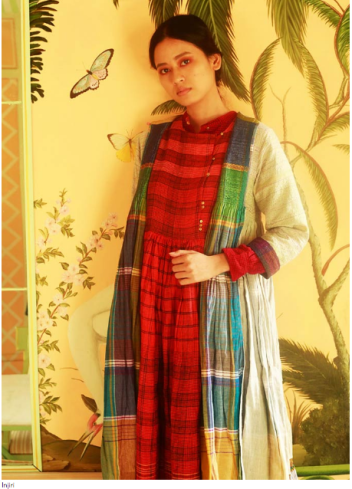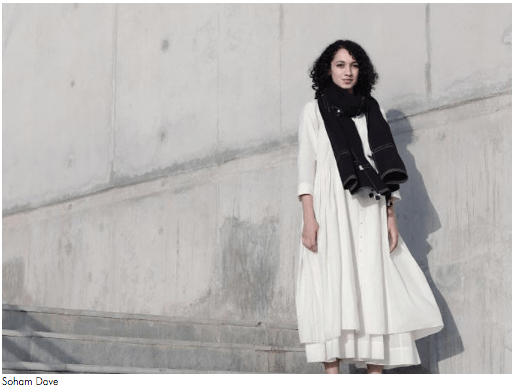Tags
Eco-friendly, Fashion, Fashion Retailers, Fashion Revolution, Natural Dyes, Sustainability, Sustainable Fashion, The Voice of Fashion, Upcycling
Published: The Voice of Fashion, September 12, 2018
 Padmaja
Padmaja
The grande dame of fashion, British designer, Vivienne Westwood, said it simply to Newsbeat at London Fashion Week a few years ago: “Buy Less, Choose Well, Make It Last.”
Fashion is the biggest pollutant in the world after oil: clothing consumption produces 1.5 tonnes of carbon dioxide per household per year—the equivalent of driving 6000 cars—as noted by the environmental documentary film, RiverBlue. 2700 litres of water are consumed in the production of a single T-shirt. Since countries with large fabric- and apparel-making industries rely mainly on fossil fuels for energy production, it is estimated that making 1 kilogram of fabric generates an average of 23 kilograms of greenhouse gases, as noted in a 2016 McKinsey article, Style That’s Sustainable.
There is a lack of transparency from luxury brands as well as fast fashion brands. For instance, it is not the case that paying more for clothes equals workers being paid well or given good working conditions.
What then makes a garment sustainable and how does a conscious consumer find one?
To begin with, research your favourite brands online to find out how they fare on the Fashion Transparency Index provided by UK-based global movement Fashion Revolution. The checklist below, while not comprehensive, helps understand the ways in which a garment impacts the world and what you can do to make better choices. Many labels noted below fall into multiple categories, but have been listed only once to avoid repetition.

Natural Dyes or AZO-Free Chemical Dyes
Toxic chemical dyes that contain Azo and fabric dyes heavy in lead, mercury and cadmium can reportedly cause cancer and sensory loss in humans and kill marine life. Look for garments that are made with natural dyes (using plant, insect or mineral bases), which are also healthier for the skin. Naturally-dyed garments must be handled carefully—they age and fade with time, so it is best to wash them in cold water with reetha (soap nut) or a mild detergent. Indian brands like Maku, Crow and Naushad Ali among others use natural dyes, while labels like Tilla also work with Azo-free chemical dyes. You can also opt for kora (undyed) garments from designers like Atelier OM and Suparna Som.

Biodegradable or Organic Fabrics
Garments made from natural sources include organic fibres spun from seeds that do not require the use of pesticides or chemicals to grow and are biodegradable. Linen—used by labels like Anavila and Padmaja—made from the fibres of the flax plant is more sustainable and stronger than cotton. That Thou Art showcases garments cut from Pochampalli Cotton which is organic and naturally dyed, while No Nasties, like the name suggests, is a fair-trade organic label. Raymond has tied up with the Khadi and Village Industries Commission to hero handspun and handwoven khadi, while Anita Dongre’s Grassroots works with eco-friendly fibres.

Recycled and Upcycled Materials
These include fabric spin-offs from the non-biodegradable waste that could choke our planet. For example, the fibre ‘Nylon 6’, is made from 100 percent regenerated waste materials including reclaimed fishing nets. It is used in Swedish Stockings’ pantyhose as well as luxury brand Stella McCartney’s Falabella Go Backpacks. Indian label Doodlage’s entire collection is made from industrial waste and recycled materials. Whereas 11.11/eleven.eleven has a refurbished line which restores naturally-dyed indigo garments from their collections that didn’t make the first cut. Payal Khandwala makes accessories from recycled studio waste.

Handcrafted
Buying from local artisans and groups encourages diversity and grass-roots level craftsmanship including that of weavers, dyers and embroiderers. Many Indian designers are going back to the loom for weaving fabric (like Akaaro by Gaurav J Gupta, Raw Mango, Injiri and Tahweave), exploring artisanal embroidery techniques (like Pero and Sabyasachi) or printing (like Poochki, Anokhi). During Lakme Fashion Week Summer/Resort ‘18’s Sustainable Fashion Day, north-eastern designers showcased collaborative collections reviving local crafts.

Low Carbon Footprint Including Energy Consumption
Designers like Soham Dave have made the low carbon footprint of clothing a part of their manifesto. His Ahmedabad-based sustainable eponymous label uses negligible electricity in the manufacturing process, which is entirely by hand.
Fair Wages and Working Conditions
Look for labels that establish higher labour and environmental standards for suppliers and set up mechanisms to make supply chains more transparent. Behno was founded in New York by Shivam Punjya to improve the situation of female artisans in Gujarat with an ethical garment factory, MSA Ethos. Designer Samant Chauhan works for the cause of his native Bhagalpur (in Bihar) master weavers, Gaurang Shah works with over 700 weavers across India and The Goodloom By GOCOOP enables handloom cooperatives and artisans to connect directly with consumers. Eka works with reliable supply chains across various parts of the country. Globally, the software company EVRYTHNG and packaging maker Avery Dennison have together launched an effort to tag clothing so consumers can trace how individual items were produced all along the supply chain.
Waste and Toxicity Management
Fashion waste comes from water, fabric, materials and energy. Tencel®, a fabric by Austrian company Lenzing, is made from sustainably-harvested trees in a ‘closed-loop’ production cycle that recycles almost 100 percent of solvent. Rajesh Pratap Singh’s androgynous garments use Tencel. Labels like Purvi Kabra, Kishmish and Ka-Sha believe in zero fabric waste, and use all the fabric scrap towards garments or accessories.

Classic and Seasonless
‘The average person buys 60 percent more items of clothing and keeps them for about half as long as was the case 15 years ago,’ noted last year’s Greenpeace report, ‘Fashion At Crossroads’. Invest in well-crafted classics and have a timeless appeal, and create new looks with layered clothing. Scandinavian designers have mastered functional garments, while local labels like Door of Maai and UK shirt brand that is made in India, Badger Badger, believe in trend-less clothing which is sustainable.

Eco-Friendly Packaging
While most sustainable designers avoid plastic and recycle their fabric scrap into bags, some go the extra mile. Eco-ethical label Nadiya Paar’s price tags can be planted, which will grow into marigold plants, while Canadian eco-ethical brand, Matt and Nat (started by a vegan Indian) has tags that can be used as bookmarks.

Retailers
While it is easiest to buy directly from sustainable designers online, reducing the retail footprint, curated stores like Janaki in Puducherry, Goa-based Paperboat Collective and Sasha’s Shop, Delhi’s Vayu at Bikaner House, Cinnamon, Raintree and Indelust in Bengaluru, Amethyst in Chennai, Byloom in Kolkata, Good Earth Sustain and Nicobar make an effort towards stocking sustainable products. Slow-fashion moving pop-ups like Pause For A Cause bring together young artisanal labels in a single space.
Disclaimer: The brand-related facts in this article, especially those with regards to fair wages and working conditions, are as reported by the labels and not verified by the publication.
